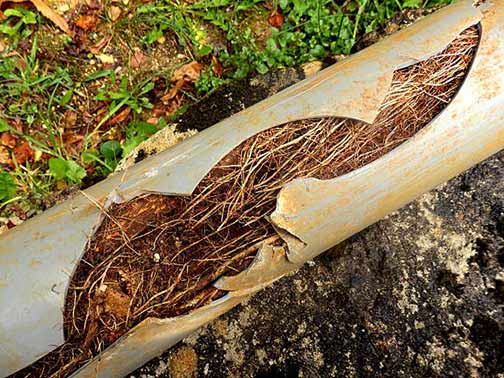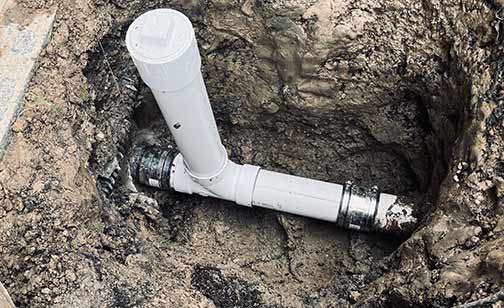
Sewer pipes are an essential component of any residential or commercial plumbing system. They are responsible for transporting wastewater and sewage from your home or business to the municipal sewer system or septic tank. Ensuring these pipes are in good working condition is crucial for maintaining a healthy and sanitary environment. A broken sewer pipe can lead to severe health hazards, property damage, and costly repairs.
Without properly functioning sewer pipes, waste materials can accumulate and cause unsanitary conditions. This can result in unpleasant odors, the spread of bacteria, and an increased risk of illness. Additionally, broken sewer pipes can lead to structural damage to your property, as water can seep into the foundation and cause cracks or erosion. Therefore, understanding the importance of sewer pipes and recognizing the signs of damage is essential for maintaining the integrity of your plumbing system.
Common Causes of Sewer Pipe Damage
Several factors can contribute to the damage of sewer pipes. Understanding these causes can help you take preventive measures and address any issues promptly:
- Tree Roots: Tree roots can infiltrate sewer pipes, causing blockages and cracks. As roots grow, they exert pressure on the pipes, leading to damage over time. Trees and shrubs naturally seek out water sources, and sewer pipes can provide an abundant supply of nutrients and moisture. As a result, roots can penetrate even the smallest cracks in the pipes and expand, causing significant damage.
- Age and Wear: Older pipes are more susceptible to corrosion, rust, and general wear and tear. Over time, this can weaken the pipes and cause them to break. Materials such as cast iron, clay, and Orangeburg (a type of bituminized fiber pipe) were commonly used in older plumbing systems and are more prone to deterioration. Regular inspections and maintenance can help identify aging pipes before they fail.
- Ground Shifting: Natural ground movements, such as settling or shifting soil, can put stress on sewer pipes and lead to cracks or breaks. Factors such as construction activities, heavy rainfall, or seismic events can cause the ground to shift and exert pressure on the pipes. In areas with expansive clay soils, seasonal changes in moisture levels can also cause the ground to expand and contract, affecting the stability of the pipes.
- Poor Installation: Improper installation of sewer pipes can result in misalignment, weak joints, and other issues that may cause the pipes to fail prematurely. Inadequate bedding and backfilling, incorrect pipe slope, and using substandard materials can all contribute to installation-related problems. Hiring an experienced plumber to install your sewer pipes can help prevent these issues.
- Clogs and Blockages: Accumulation of debris, grease, and other materials can cause blockages in the sewer pipes. Persistent clogs can lead to increased pressure and eventual pipe damage. Common culprits include cooking grease, hair, soap scum, and foreign objects that are flushed down toilets or washed down drains. Regular maintenance, such as drain cleaning and proper waste disposal, can help prevent clogs from forming.
Warning Signs of a Broken Sewer Pipe
Recognizing the warning signs of a broken sewer pipe is essential for addressing the issue before it escalates. Here are some common indicators to watch for:
Unpleasant Odors
One of the most noticeable signs of a broken sewer pipe is the presence of foul odors. If you detect a persistent smell of sewage in your home or yard, it could indicate a leak or break in the sewer line. These odors are not only unpleasant but can also pose health risks if left unaddressed.
Sewer gas contains harmful substances such as hydrogen sulfide, ammonia, and methane, which can cause respiratory problems, headaches, and other health issues when inhaled over time. If you notice sewage odors in your home, it’s important to investigate the source and address it promptly to ensure the safety and well-being of your household.
Slow Drains
Another common sign of a broken sewer pipe is slow-draining sinks, tubs, or toilets. If multiple drains in your home are experiencing slow drainage simultaneously, it could be a sign of a blockage or damage in the main sewer line. Persistent slow drains should be inspected by a professional plumber to determine the underlying cause.
Slow drainage can be caused by a partial blockage, pipe collapse, or root intrusion. Ignoring this issue can lead to more severe problems, such as complete blockages or sewage backups, which can cause significant damage to your property and require extensive repairs.
Unusual Sounds
Gurgling or bubbling sounds coming from your drains can indicate a problem with your sewer pipes. These noises are often caused by trapped air or blockages in the pipes, which can be a sign of damage or a potential break. If you hear unusual sounds from your plumbing system, it’s essential to have it checked by a professional.
Gurgling sounds can occur when air is forced through water in the pipes due to a blockage or improper venting. This can create negative pressure in the plumbing system, leading to slow drainage and potential sewer gas odors. Addressing the issue promptly can help prevent further damage and ensure the proper functioning of your plumbing system.
Water Backups
Water backups in your sinks, tubs, or toilets are a clear indication of a problem with your sewer system. If wastewater is backing up into your home, it could mean that there is a blockage or break in the sewer line. This issue requires immediate attention to prevent further damage and potential health hazards.
Sewer backups can lead to water damage, mold growth, and contamination of your living spaces. It’s crucial to address the root cause of the backup and restore proper drainage to protect your home and health. A professional plumber can diagnose the problem and recommend the appropriate repairs to resolve the issue.
Lush Patches of Grass
If you notice unusually green and lush patches of grass in your yard, it could be a sign of a leaking sewer pipe. The nutrients in the sewage can promote the growth of grass and plants, leading to uneven patches in your lawn. While this may seem like a positive sign, it indicates a serious underlying issue that needs to be addressed.
Leaking sewage can contaminate the soil and groundwater, posing environmental and health risks. Additionally, the excess moisture can attract pests and create favorable conditions for mold and mildew growth. It’s important to investigate the cause of the lush patches and repair any leaks in the sewer system to prevent further damage and potential hazards.
Foundation Cracks
Cracks in your home’s foundation can be a sign of a broken sewer pipe. Leaking water from the sewer line can cause the soil to shift and settle, leading to cracks in the foundation. If you notice new or worsening cracks in your foundation, it’s essential to investigate the cause and address any potential sewer pipe issues.
Foundation damage can compromise the structural integrity of your home and lead to costly repairs. Addressing sewer pipe problems promptly can help prevent further damage and protect your property. A professional plumber can assess the condition of your sewer system and recommend the necessary repairs to resolve the issue.
Pest Infestations
A broken sewer pipe can attract pests such as rodents, insects, and other critters. These pests are drawn to the moisture and nutrients in the sewage. If you notice an increase in pest activity around your home, it could be a sign of a sewer pipe problem. Addressing the issue promptly can help prevent further infestations and damage.
Pests such as rats, cockroaches, and flies can carry diseases and contaminate your living spaces. Repairing broken sewer pipes and eliminating standing water and waste can help deter pests and protect your home from infestations. Regular maintenance and inspections can help identify and address potential issues before they become major problems.

Addressing a Broken Sewer Pipe
Once you’ve identified the warning signs of a broken sewer pipe, it’s crucial to take immediate action to address the issue. Here are some steps to follow:
Contact a Professional Plumber
Hiring a professional plumber is essential for accurately diagnosing and repairing a broken sewer pipe. A licensed plumber will have the expertise and equipment needed to identify the source of the problem and recommend the best course of action.
Attempting to repair a sewer pipe on your own can be risky and may result in further damage or incomplete repairs. A professional plumber can ensure that the issue is resolved safely and effectively.
Inspect and Diagnose
The plumber will conduct a thorough inspection of your sewer system to determine the extent of the damage. This may involve using specialized cameras to inspect the interior of the pipes and identify any blockages, cracks, or breaks.
Video inspection technology allows plumbers to see inside the pipes without excavation, making it easier to pinpoint the problem and develop an appropriate repair plan. The plumber may also perform tests such as smoke testing or dye testing to detect leaks and assess the overall condition of the sewer system.
Repair or Replace
Depending on the severity of the damage, the plumber may recommend repairing or replacing the affected sewer pipe. Minor cracks or blockages can often be repaired using techniques such as pipe relining or hydro jetting. Pipe relining involves inserting a flexible liner coated with resin into the damaged pipe and curing it to form a new, seamless pipe within the old one. Hydro jetting uses high-pressure water to clear blockages and clean the interior of the pipes.
However, more extensive damage may require the replacement of the damaged section of the pipe. In some cases, trenchless technology can be used to replace pipes with minimal excavation, reducing disruption to your property.
Preventative Measures
After addressing the immediate issue, it’s essential to take preventative measures to avoid future sewer pipe problems. Regular maintenance, proper disposal of waste, and monitoring for early warning signs can help keep your sewer system in good working condition.
Schedule routine inspections and sewer rodding cleanings with a professional plumber to identify and address potential issues before they become major problems. Avoid flushing non-biodegradable items, grease, and other debris down your drains to prevent clogs and blockages. Additionally, consider installing backflow prevention devices to protect your home from sewer backups.
To Sum It Up
Being aware of the warning signs of a broken sewer pipe is crucial for maintaining a healthy and functional plumbing system. By recognizing these signs early and taking prompt action, you can prevent costly repairs and potential health hazards. Regular maintenance and professional inspections can help ensure your sewer pipes remain in good condition, providing peace of mind and a safe living environment.
Taking proactive steps to protect your sewer system can save you time, money, and stress in the long run. Remember, when in doubt, always consult a professional plumber to address any concerns with your sewer system and keep your home safe and sanitary.

